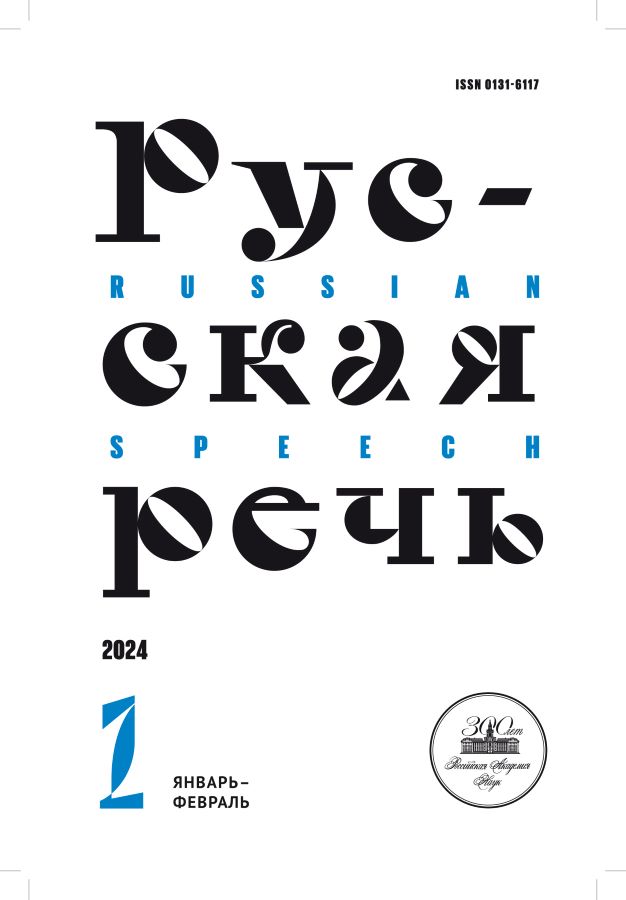“Fresh or not Fresh?” (Linguistic Portraying of the Word Фреш (Fresh) in Modern Journalistic Discourse)
- Authors: Sokolova M.G.1
-
Affiliations:
- Togliatti State University
- Issue: No 1 (2024)
- Pages: 49-59
- Section: Issues of Modern Russian Language
- URL: https://freezetech.ru/0131-6117/article/view/652457
- DOI: https://doi.org/10.31857/S0131611724010042
- ID: 652457
Abstract
The article examines the features of the functioning of the lexeme фреш (fresh) in modern journalistic discourse within the framework of the language portrait. The active spheres of functioning of the word фреш (fresh) in accordance with the subject of the texts are highlighted. The semantic volume of this lexeme has been clarified, which includes several meanings: “freshly squeezed juice”; “fresh, natural food”; “fresh, natural, original, new.” It has been established that the development of the semantics of the lexeme demonstrates the process of expanding the semantic volume due to the loss of hypersemes (“juice”, “food”) and the expansion of lexical compatibility. The morphological polyfunctionality of the analyzed lexeme, which acts as a noun or an indeclinable adjective as part of analytical constructions, is demonstrated. The facts of the expressive use of the word фреш (fresh) as proper names are described, as well as the inclusion of precedent phenomena in the game transformation. It has been established that while maintaining variability in the spelling of the word, the variant фреш (fresh) becomes predominant in frequency; various ways in the design of this word in the position of postposition in combinations are characterized.
Full Text
About the authors
Marina G. Sokolova
Togliatti State University
Author for correspondence.
Email: msok71@mail.ru
Russian Federation, Togliatti
References
- Apresyan Yu. D. [Basic principles and concepts of system lexicography]. Yazykovaya kartina mira i sistemnaya leksikografiya [Language picture of the world and system lexicography]. Moscow, Yazyki Slavyanskikh Kul’tur Publ., 2006, pp. 33–74. (In Russ.)
- Bychkova V. S. [Nominations “provincial” and “she-provincial” in lexicographic coverage]. Paradigma sovremennoi nauki v usloviyakh modernizatsii i innovatsionnogo razvitiya nauchnoi mysli: teoriya i praktika: Sbornik materialov ХVI mezhdunarodnoi nauchno-prakticheskoi konferentsii, posvyashchennoi pamyati osnovatelei Kostanaiskogo filiala CheLGU T. Zh. Atzhanova i A. M. Rodnova, Kostanai, 12–13 aprelya 2022 goda [The paradigm of modern science in the conditions of modernization and innovative development of scientific thought: theory and practice: A collection of materials of the XVI International Scientific and Practical Conference dedicated to the memory of the founders of the Kostanay branch of ChelSU T. Zh. Arzhanov and A. M. Rodnov, Kostanay, April 12–13, 2022]. Kostanay, 2022, pp. 459–463. (In Russ.)
- Dolgova E. Yu. [Lexicographical portrait of the lexeme “pogryaznut’” (X–XVII centuries)]. Aktual’nye voprosy sovremennoi filologii i zhurnalistiki, 2020, no. 4 (39), pp. 23–29. (In Russ.)
- Koss E. V. [Lexicographic portrait of the word дядя (uncle) in secondary naming]. Filologicheskie nauki. Voprosy teorii i praktiki, 2023, Volume 16, Issue 3, pp. 789–795. (In Russ.)
- Krysin L. P. Inoyazychnye slova v sovremennom russkom yazyke [Foreign words in modern Russian]. Moscow, Nauka Publ., 1968. 208 p.
- Krysin L. P. Russkoe slovo, svoe i chuzhoe: Issled. po sovrem. rus. yaz. i sotsiolingvistike [The Russian word, one’s own and someone else’s: Studies in Modern Russian and sociolinguistics]. Moscow, Yazyki Slavyanskikh Kul’tur Publ., 2004. 883 p.
- Litvinov S. V. [Anglicisms in the Russian language of the XVI–XIX centuries (Historical and cultural aspect)]. Russkaya rech’, 2004, no. 6, pp. 99–102. (In Russ.)
- Marinova E. V. Inoyazychnaya leksika sovremennogo russkogo yazyka: uchebnoe posobie [Foreign language vocabulary of the modern Russian language: a textbook]. Moscow, Flinta Publ., Nauka Publ., 2013. 292 p.
- Natsional’nyi korpus russkogo yazyka [Russian National Corpus]. Available at: http:// ruscorpora.ru (accessed 21.04.2023).
- Nemich N. N. [Lexicographic description of synonymous constituents in the field of inexpressible semantics]. Izvestiya Yuzhnogo federal’nogo universiteta. Filologicheskie nauki, 2022, Volume 26, Issue 2, pp. 34–46. (In Russ.)
- Parshina O. D. [Lexicographical representation of the “province” concept]. Mir nauki. Sotsiologiya, filologiya, kul’turologiya, 2019, Volume 10, Issue 4, p. 47. (In Russ.)
- Popova T. V., Ratsiburskaya L. V., Gugunava D. V. Neologiya i neografiya sovremennogo russkogo yazyka: uchebnoe posobie [Neology and neography of the modern Russian language: a textbook]. Moscow, Flinta Publ., 2011. 168 p.
- Shagalova E. N. Samyi noveishii tolkovyi slovar’ russkogo yazyka XXI veka: ok. 1500 slov [The newest explanatory dictionary of the Russian language of the 21st century: approx. 1500 words]. Moscow, AST Publ., Astrel’ Publ., 2011. 413 p.
- Sherstyanykh I. V. [On a lexicographic portraying of the word “life”]. Vestnik IGLU, 2011, no. 2 (14), pp. 62–68. (In Russ.)
- Skovorodnikov A. P. Ehkologiya russkogo yazyka [Ecology of the Russian language]. Krasnoyarsk, Sib. Feder. Univ. Publ., 2013. 388 p.
- Sokolova M. G. [Cultural and speech problems of the use of borrowed words in modern mass communication]. Sovremennoe russkoi yazykoznanie i lingvodidaktika. Sbornik nauchnykh trudov, posvyashchennyi 85-letiyu so dnya rozhdeniya akademika RAO N. M. Shanskogo [Modern Russian linguistics and linguodidactics. Collection of scientific papers dedicated to the 85th anniversary of the birth of Academician N. M. Shansky]. Moscow, 2007, pp. 151–157. (In Russ.)
- Sorokin Yu. S. Razvitie slovarnogo sostava russkogo literaturnogo yazyka. 30–90 gody XIX veka [Development of the vocabulary of the Russian literary language. 30–90 years of the XIX century]. Moscow, Leningrad, Nauka Publ., 1965. 565p.
- Timofeeva G. G. [Some features of the adaptation of neologisms with elements rock- and show- in modern Russian]. Fonetika i pis’mo v ikh razvitii: mezhvuz. sb. nauch. tr. [Phonetics and writing in their development: inter-university collection of scientific truth]. Omsk, 1992, pp. 77–84. (In Russ.)










